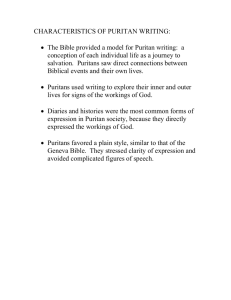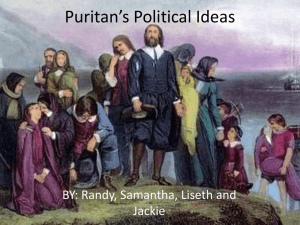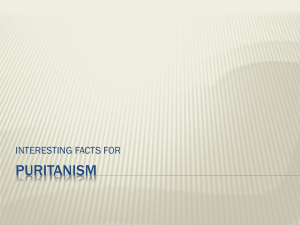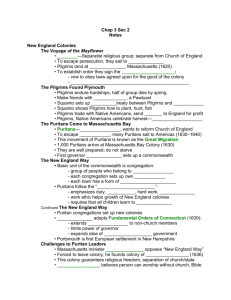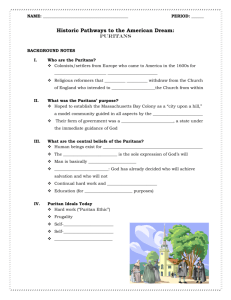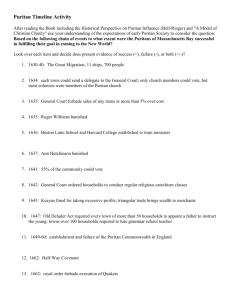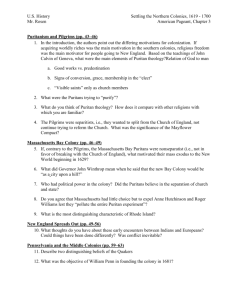Puritanism Notes
advertisement
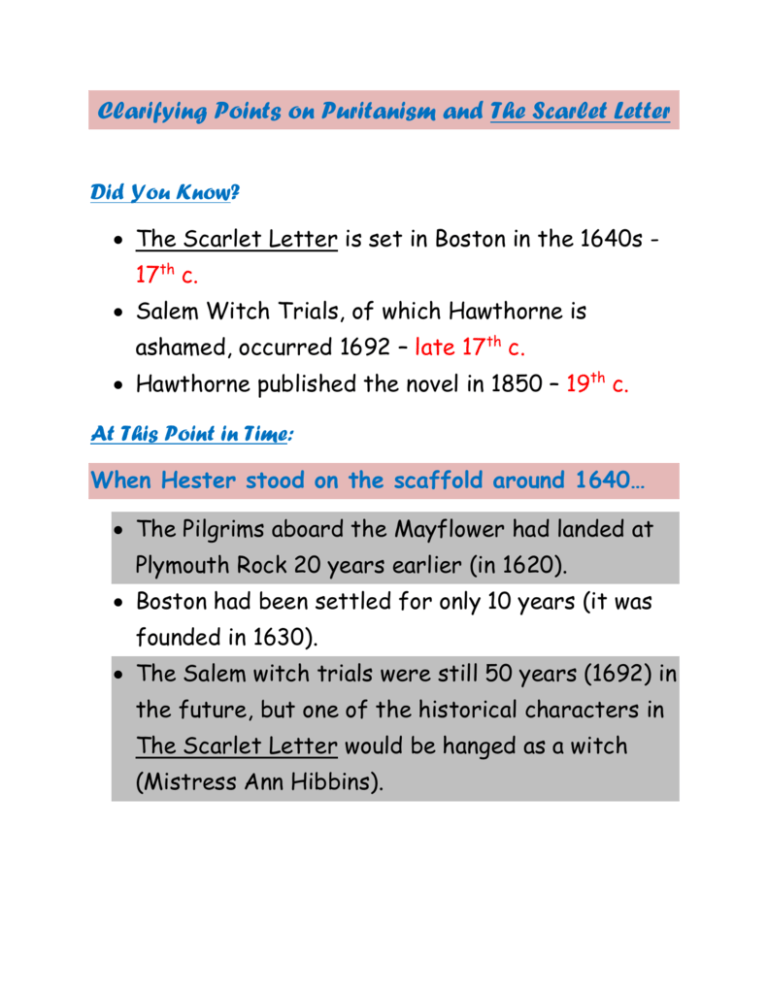
Clarifying Points on Puritanism and The Scarlet Letter Did You Know? The Scarlet Letter is set in Boston in the 1640s 17th c. Salem Witch Trials, of which Hawthorne is ashamed, occurred 1692 – late 17th c. Hawthorne published the novel in 1850 – 19th c. At This Point in Time: When Hester stood on the scaffold around 1640… The Pilgrims aboard the Mayflower had landed at Plymouth Rock 20 years earlier (in 1620). Boston had been settled for only 10 years (it was founded in 1630). The Salem witch trials were still 50 years (1692) in the future, but one of the historical characters in The Scarlet Letter would be hanged as a witch (Mistress Ann Hibbins). Who are the Puritans? Today the term refers to someone who has extremely strict moral standards. In 16th and 17th centuries, though, Puritans were political and religious revolutionaries. Began as members of The Church of England However, the objected to abuses they saw in the church: Riches (stained glass, gold candlesticks, fine vestments, etc.) Wealthy bishops making church policy Aims: 1. Return to values of early Christianity a. shun materialism: return to hard work and simplicity 2. To Purify the Church a. remove all traces of Catholicism from The Church and its practices (see above) b. recognize Bible as sole source of authority 3. To Establish a Theocracy (Where God’s word is interpreted by ministers; their interpretations are the basis for law/governing) 4. To Provide a Place for Puritans to Worship Freely (NOT intended to provide religious freedom for all – they dealt harshly with those who openly differed from their beliefs) Beliefs: 1. Predestination 2. Limited Atonement 3. Total Depravity 4. Irresistible Grace 5. Bible - sole source of religious authority Behavior: 1. Worked hard (Idle hands do the Devil’s work) 2. Persecuted other religious groups 3. Punished all sinners harshly 4. Educate all (How else can you read your Bible? Explain the hypocrisy. Because of their severity and hypocrisy, “Puritan” is a disparaging term today. Is there a difference between the Pilgrims and the Puritans? YES! What’s the Same: Both groups disagreed with Queen Elizabeth’s (1558-1601) approach to stabilizing the country through religious tolerance. Elizabeth I realized that any religious extremism would result in strife, and she wanted peace; England and its church should be inclusive. Nonconformist groups (Puritans and Pilgrims) wanted to bring The Church of England to a state of purity (for example, by removing the finery, vestments, and ceremony from The Church), hence the name “Puritan.” Unsuccessful attempts to reform The Church of England resulted in persecution, which caused many to migrate to America. What’s different? Puritans didn’t leave the Anglican Church – they sought to reform it from within. o They had set sail from England with a dream. Their new nation would be a guiding light- an example for the whole world. Once The Church of England saw the exemplary community, how could it deny the Puritans’ righteous ways? o John Winthrop (minister and governor of Mass. Bay Colony) said the colony was a shining “City Upon A Hill” and that “the eyes of all people are upon us.” They represented the “pure” Church of England and planned to return to England and replace the corrupt church. This was the Puritan vision for America. o It isn’t surprising they established a theocracy in New England, so the church could influence government; every part of their lives (religious, political, and social) was influenced by The Church. Hence, Christianity could be more like it was during Christ’s life. Pilgrims were Separatists – They left the Church and England: they never planned to return to England. Is The Scarlet Letter romantic literature? Yes, thus it will . . . 1. Deal with the strange and mysterious 2. Characterize the noble characters as intuitive and imaginative 3. Turn to the past for subject matter 4. Show a distrust of civilization while representing nature positively (though paradoxically) 5. Paint passion and emotion positively Whatever happened to the Puritans? (FYI: Don’t need to write) Steeples on Meetinghouses, Cushions in Pews “The Massachusetts Bay Colony’s founders envisioned a model community of ideal Puritan life. But it could never be. Other immigrants trickled in, and some didn't share the Puritan vision. Meanwhile, American-born children of the early Puritans didn't share the same religious passion of their parents. Many congregations loosened the rules on membership to maintain their numbers. Stern Puritanism over time slipped into gentler Congregationalism. The early plain steepleless meetinghouses gave way to steepled buildings that looked more like churches, even though they were still called meetinghouses. The boxed pews started to be equipped with cushions.” “Eventually the Congregationalists had a crisis, producing a split, with one branch remaining Congregationalists and the other forming Unitarian churches. The remaining Congregationalists eventually came together with churches rooted in the German Reformed traditions, forming an association now called the United Church of Christ. The Unitarians, meanwhile, merged with Universalists, and now are known as Unitarian Universalists.” The transcendental movement (Henry David Thoreau, Ralph Waldo Emerson, and Margaret Fuller) will emerge from the Unitarian Church! Sources: Conforti, Joseph A., Saints and Strangers: New England in British North America. Baltimore, Johns Hopkins University Press, 2006. Labaree, Benjamin W., Colonial Massachusetts: A History. Millwood, New York, KTO Press, 1979. Morris, Michelle. "Plymouth Colony." World Book Student. World Book, 2009. Web. 29 Sept. 2009. Starkey, Marion L., “The Congregational Way: The Role of the Pilgrims and Their Heirs in Shaping America,” Garden City, New York, Doubleday & Company, 1966. Unitarian Controversy and Its Puritan Roots
